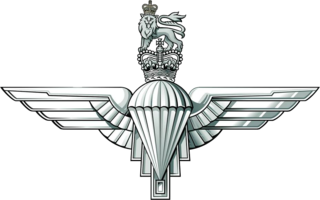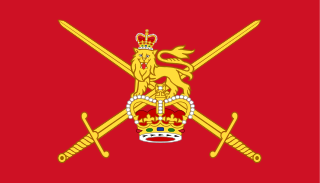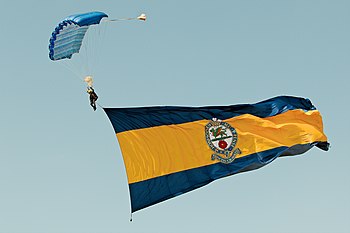
A paratrooper is a military parachutist—someone trained to parachute into a military operation, and usually functioning as part of an airborne force. Military parachutists (troops) and parachutes were first used on a large scale during World War II for troop distribution and transportation. Paratroopers are often used in surprise attacks, to seize strategic objectives such as airfields or bridges.
The Infantry of the British Army, comprises 49 infantry battalions, from 19 regiments. Of these, 33 battalions are part of the Regular army and the remaining 16 a part of the Army Reserve. The British Army's Infantry takes on a variety of roles, including armoured, mechanised, air assault and light.

The Parachute Regiment, colloquially known as the Paras, is an airborne infantry regiment of the British Army. The first battalion is part of the Special Forces Support Group under the operational command of the Director Special Forces. The other battalions are the parachute infantry component of the British Army's rapid response formation, 16 Air Assault Brigade. The Paras, along with the Guards, are the only line infantry regiment of the British Army that has not been amalgamated with another unit since the end of the Second World War.

The Royal Corps of Signals is one of the combat support arms of the British Army. Signals units are among the first into action, providing the battlefield communications and information systems essential to all operations. Royal Signals units provide the full telecommunications infrastructure for the Army wherever they operate in the world. The Corps has its own engineers, logistics experts and systems operators to run radio and area networks in the field. It is responsible for installing, maintaining and operating all types of telecommunications equipment and information systems, providing command support to commanders and their headquarters, and conducting electronic warfare against enemy communications.

In military organizations, a pathfinder is a specialized soldier inserted or dropped into place in order to set up and operate drop zones, pickup zones, and helicopter landing sites for airborne operations, air resupply operations, or other air operations in support of the ground unit commander. Pathfinders first appeared in World War II, where they served with distinction, and continue to serve an important role in today's modern armed forces, providing commanders with the option of flexibly employing air assets.

The Princess of Wales's Royal Regiment is the senior English line infantry regiment of the British Army, second in the line infantry order of precedence to the Royal Regiment of Scotland and part of the Queen's Division.

The Parachute Regiment is an airborne and special forces regiment of the Indian Army. It was raised in 1945 as part of the British Indian Army but was disbanded after World War II and was re-raised in 1952 as part of the Indian Army. Currently it consists of fifteen Special Forces, two Territorial Army and one Rashtriya Rifles battalions.

16 Air Assault Brigade Combat Team, from 1999 to 2021 16 Air Assault Brigade, is a formation of the British Army based in Colchester in the county of Essex. It is the Army's rapid response airborne formation and is the only brigade in the British Army focused on delivering air assault operations.
The British Army primarily divides its infantry into regiments, which are subdivided into battalions. However, for various reasons, since the end of the Second World War it has also maintained companies that are intended to provide increments and reinforcements.

The 5th Infantry Brigade was a regular infantry brigade of the British Army that was in existence since before the First World War, except for a short break in the late 1970s. It was an Airborne Brigade from the early 1980s until amalgamating with 24th Airmobile Brigade, in 1999, to form 16 Air Assault Brigade.

The 2nd Parachute Brigade was an airborne forces brigade formed by the British Army during the Second World War.

The maroon beret in a military configuration has been an international symbol of airborne forces since the Second World War. It was first officially introduced by the British Army in 1942, at the direction of Major-General Frederick "Boy" Browning, commander of the British 1st Airborne Division. It was first worn by the Parachute Regiment in action in North Africa during November 1942.
7th Parachute Regiment, Royal Horse Artillery is a regiment of the Royal Artillery in the British Army. It currently serves in the field artillery role with 16 Air Assault Brigade Combat Team, and is equipped with the L118 Light Gun.
A large regiment is a multi-battalion infantry formation of the British Army. First formed in the 1960s, large regiments are the result of the amalgamation of a number of existing single-battalion regiments, and perpetuate the traditions of each of the predecessor units.

23 Parachute Engineer Regiment is a Royal Engineers regiment in the British Army that was formed in 2003. It provides engineer support to 16 Air Assault Brigade in both the parachute and air assault role. The regiment is currently based at Rock Barracks in Suffolk and consists of three regular squadrons and one Army Reserve squadron. As part of 16 Air Assault Brigade it can be called upon to deploy on operations across the globe at extremely short notice.

The 5th (Scottish) Parachute Battalion was an airborne infantry battalion of the Parachute Regiment, raised by the British Army during the Second World War.

The structure of the British Army of the United Kingdom (UK) is currently being reorganised to the Future Soldier structure. Due to these reforms taking place gradually, it is likely that some areas will not be fully complete. The British Army is commanded by the Chief of the General Staff (CGS), with Army Headquarters which is located in Andover, Hampshire. Subordinate to that post, there is a Commander Field Army, and a personnel and UK operations command, Home Command.
This is a list of units of the British Army's Royal Engineers.














